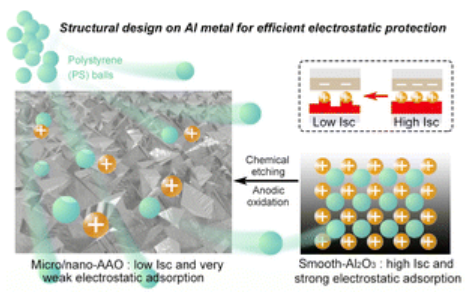Abstract
The instantaneous discharge of accumulated static charge due to contact electrification can cause irreversible damage to electrostatic-sensitive systems. Despite major advances in reducing tribo-charges, the problem remains intractable. Here, four alumina microstructures are fabricated on aluminum (Al) by combining chemical etching and anodic oxidation, and the effects of surface composition and structure on the triboelectric performance are studied by assembling them with a polytetrafluoroethylene membrane into a solid-solid triboelectric nanogenerator. The results show that the short-circuit current of the hierarchical nanoporous anodic aluminum oxide (micro/nano-AAO) modified Al is 8.77 times smaller than that of pristine Al, which is attributed to the reduced contact area and presence of an oxide film on the surface of the modified metal. By regulating the diameter of alumina nanotubes, a positive correlation between the contact area and the measured charge density is theoretically demonstrated, which establishes the size of the contact area as the main factor affecting triboelectric outputs. In addition, the micro/nano-AAO based phone shell could provide more effective electrostatic protection than that based on an acrylic coating. This novel regulation of the triboelectric output by microstructural design provides a new direction for the development of antistatic materials in a vacuum and non-grounded environment.

Keywords Plus:CHIP ESD PROTECTIONFRICTION LAYERCONTACTNANOGENERATORSTEMPLATESMECHANISMALUMINUMCHARGESFILM
Published in NANOSCALE,Volume14;10.1039/d2nr03445j,OCT 21 2022


